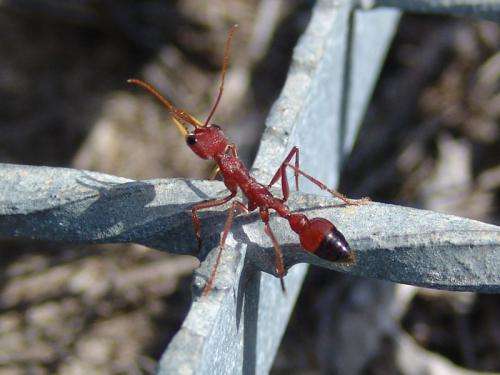Ants pay high price for night life

(Phys.org) —Despite being night creatures, Australian bull ants have trouble finding their way home in the dark. Scientists at Australia's Vision Centre (VC) have found that bull ants that travel at night take much longer to reach home compared to those that return at dawn. The 'night travellers' are also less likely to find their nests, the study shows.
"To cope with dim or dark environments, night-active ants have larger lenses and wider photoreceptors – to capture light – compared to their day-active relatives," says Dr Ajay Narendra of the VC and The Australian National University (ANU). "We found that even with this compensation, the nocturnal bull ants still take longer to get to their food sources or nests at night.
"Our study shows that this is because these ants rely predominantly on surrounding landmarks to navigate, and that landmark information is less salient in the dark."
Using a Differential GPS, the researchers tracked individual ants with centimetre accuracy. A satellite base station is placed close to the ants' nest providing precise spatial coordinates. The scientists then follow an ant, using a roaming GPS. Information exchanged between the roaming GPS and the base station gives the ant's position with an accuracy of a few centimetres.
The researchers found that bull ant workers leave their nests during twilight to forage on a nearby Eucalyptus tree, and ants that leave the nest early – within 10 minutes of sunset – reach the tree faster than those that leave an hour after sunset.
"The 'late' ants walked more slowly, stopped more frequently and paused for longer compared to the early foragers. They were also less able to travel in a straight path," Dr Narendra says.
The study also shows that while most of the bull ants return to the nest at dawn, 10 per cent of them start their journey home at midnight and take much longer to reach their nest.
For instance, one ant that returned home at midnight took 4.5 hours to reach her nest, but she needed only three minutes to cover the same distance when she went home at dawn on another day.
"The ants that return throughout the night are workers that have captured prey," Dr Narendra explains. "Once they've found a spider or a wasp, there's no point in hanging around. The best thing to do is to store the prey in a safe place, and the safest place is home."
On the other hand, bull ants that go on self-nourishing trips where they feed on honeydew produced by sap-sucking insects climb and stay on the Eucalyptus tree during the dark periods of the night and travel home in the dim light conditions at dawn.
To find out why ants travel more slowly at night, the researchers captured and displaced them in an area outside of their typical foraging route in bright and dark conditions.
"If the displaced ants used a sky compass – the pattern of polarised skylight – for navigation, they would have travelled ignoring the displacement and headed to where the nest should be – even if it isn't actually there," Dr Narendra explains.
"But once we released them, the ants that were let go in bright conditions went home directly and the 'dark' ants began searching for landmarks immediately," he says.
"This means that bull ants rely heavily on the surrounding landmarks and less on sky compass for navigating during both bright and dark conditions. And in the dark conditions, landmarks are less salient – this is why they take much longer to complete their journey then."
Dr Narendra says this may be why most of the bull ant workers travel in the dim light conditions of twilight or dawn, as they have just enough light to gather navigational information.
"The most efficient way of navigating is walking in a straight line to and from the food source," he says. "If their paths are less straight, they stay outside for longer and are exposed to predation, food-robbing and other threats."
"So travelling in the dark comes at an enormous cost to these bull ants. And given they are better navigators in bright light conditions, it raises the question of why they remain so stubbornly night-active throughout the year."
The study "Navigational efficiency of nocturnal Myrmecia ants suffers at low light levels" by Ajar Narendra, Samuel F. Reid and Chloé A. Raderschall was published in PLOS ONE.
More information: Narendra A, Reid SF, Raderschall CA (2013) Navigational Efficiency of Nocturnal Myrmecia Ants Suffers at Low Light Levels. PLoS ONE 8(3): e58801. doi:10.1371/journal.pone.0058801
Journal information: PLoS ONE
Provided by Australian National University




















